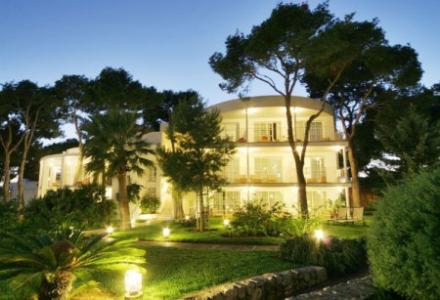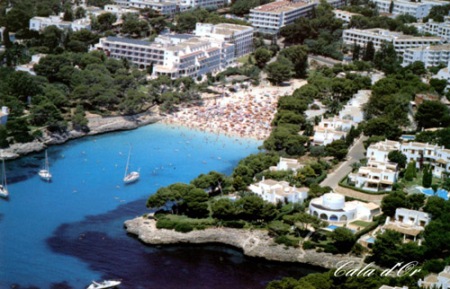They built their white, flat-roofed houses around the picturesque fishing harbour, and soon the word spread. Cala d’Or became a desirable spot to have a holiday home, or for a relaxing seaside vacation. The original village and harbour was situated in one of the small rocky coves with sandy beaches, called ‘calas’, that abound on Mallorca’s east coast.
The resort has now spread out to encompass several of these coves, all now beset with attractive hotels, apartment blocks and villas. It is a very chic resort, recommended for families because most establishments cater extremely well for children. There are numerous adjacent smaller resorts and quaint villages clustered around the calas all along the south-east coastline, connected by a good bus service, which means visitors can make excursions to explore the delights of places like Cala Egos, Puerto Petro, Cala Mondrago, Cala Figuera, Cala Santanyi and Cala Llombarts. The Cala d’Or marina is the heart of the east coast resort area, attracting the fashionable yachting set.
Locality:
Cala d’Or is situated on the SE coast, 8 mls NE of Santanyi, 10 mls
SE of Felanitx, 40 mls SE of Palma and the airport. The area is set on a
series of 8 or 9 coves that go by the collective name of Cala d’Or.
Most are deep inlets edged with grey rocks and pine woods.Shopping: Cala d’Or is known as the best shopping district on Mallorca, its main shopping street, Avinguda Tagomago, filled with chic boutiques, leather shops and galleries. Designer clothes and shoes, in particular, are available at reasonable prices. For designer wear a good port of call is Irocco on Avinguda Tagomago, and for a classy pair of shoes to match the outfit visit the exclusive Farrutx store near Placa Ibiza. Trendy clothes are available at two Piscies outlets in the town centre. Souvenir shopping is fun with the wide variety of local crafts, traditional pottery and glass, and olive wood carvings available at several stores, and at the Sunday morning flea market in Felanitx. Visitors can also find bargains in designer sunglasses, jewellery and perfume.
Those in self-catering apartments who need sustenance will find all they
require at the resort’s biggest supermarket, Caprabo, near the resort
entrance.
Cala d’Or’s has a varied range of eateries with upmarket restaurants
situated around the marina, which is usually abuzz with a lively
international crowd enjoying a variety of cuisines. The centre of town
offers fast food outlets, tapas bars, pizza parlours, burger joints and
several British pub ‘n grub type establishments. At the marina try the
Café Continental for snacks and sandwiches, or Blanco y Negro for pizzas
and seafood. Port Petit is a high-class seafood restaurant renowned for
quality and service. Aquarius and El Yate are two other good choices
for top quality international cuisine at the marina.By night Cala d’Or is tasteful and stylish, rather than frenetic, centred around the many cocktail bars and discos.
Popular daytime activies are mainly centred around the seven beaches, of
which the largest is Cala Gran, all with fine white sand and clear
shallow water. The larger beaches have good facilities offering
watersports including sailing, windsurfing and scuba-diving. Those
wishing to venture further afield can take a ‘champagne cruise’ along
the coastline, ride a mini-train to picturesque Cala Mondrago with its
two lovely coves, or take excursions to the villages of Cala Figuera,
Puerto Petro, Sa Colonia de Sant Jordi or the isle of Cabrera.
Most hotels offer full entertainment programmes for children, and
there are trampolines and mini go-karts at Mallorcalandia, as well as
mini-golf in the town centre. Cala d’Or is definitely a family-oriented
resort, not catering for the 18-30 single set, particularly those who
enjoy a wild night-life. The music bars and discos are usually quiet by
2am. The main resort beaches can become enormously crowded, particularly
during July and August, and holiday-makers have to be up and about
early if they hope to secure a sunbed for the day. It is possible to
bus, or hire a car, to travel to nearby less populated beaches and
coves, but these are not likely to offer all the facilities of the
resort beaches.
Popular Attractions/Activities/Excursions: Arta: The ancient
hilltop town of Arta close to the east coast of Mallorca has been
occupied for about 3,000 years, and today welcomes visitors to the
remains of its Bronze Age settlement at Ses Paisses, just outside the
town in a grove of olive, carob and holm oak trees. Arta presents a
picturesque sight from the Santuari de Sant Salvador, the chapel-shrine
on top of the hill, with its bleached rooftops spilling down the
hillside below the battlements of a Moorish fortress. The town is
particularly lively on Tuesdays, which is market day. Castell d’Alaro :
Mallorca’s most popular hiking trail is the climb from the town of Alaro
up to a ruined castle and hilltop chapel, which offers panoramic views
of the sea and plains as far as Palma. From Alaro the walk takes about
two hours to complete. The castle ruins on the hilltop date from the
15th century and dominate the landscape. At the summit there is a
restaurant and bar to refresh weary climbers. On Sundays the trail
becomes rather busy.
Excursions: This part of the E coast is not ideal for tours,
as the roads tend to be narrow and winding and many of the principal
sights are on the opposite side of the island. Caves of Drach and Ham
are, however, a convenient half-day trip. Other tours, including Palma,
are generally full-day tours. Alcudia old town and Formentor Peninsula.
The NW mountains; monastery at Lluc, Soller, Deya, Valldemosa. Boat
cruises. Jeep safaris.








0 comments:
Đăng nhận xét